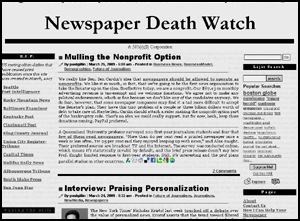Print journalists are forced to fight for their livelihoods in the Online Age
My mom was furious. She had just received notice from her hometown newspaper that her paper would no longer be delivered on her porch. It would be dumped at the top of her driveway instead.

“How in the hell do they expect me to find my paper in the winter when it snows?” she grumbled.
“Good question, ma. Why don’t you just cancel your subscription and read the paper online like everybody else?” I asked.
Ohhhh. Those were fighting words. See, after 30 years of reading the same newspaper every day, it sort of becomes a habit. The paper is part of my mom’s daily routine. She really can’t live without it. And computers kind of creep her out.
So, I suggested she call the paper to complain. She did, and it was all a big mix-up, after all. My mom still gets her morning paper on her porch. Thank God!
If only all newspaper subscribers were as loyal as my dear, sweet mother. In that case, the industry wouldn’t be gasping for air, as it is now.
The problem, as Mark Potts, of the Recovering Journalist blog, puts it, is that my mom is part of “a certain older, dwindling audience.”
Thanks, Mark. I’ll be sure to let my mom know that she’s “old and dwindling.”
But wait, there’s more …
What Ails Newspapers?
Newspapers in America have seen better days. Print publications are losing readers to the Internet at an alarming rate. And online classified ad sites like Craigslist and Monster are shrinking the papers’ revenue even faster.
Add to that the economic recession and high debt loads, and it pretty much spells certain disaster. Major newspaper companies have seen their stock prices battered by 90 percent in the past couple of years.
“It’s rather amazing to watch the whole industry head off the cliff together,” observes Mark Potts, everyone’s favorite Recovering Journalist (http://recoveringjournalist.typepad.com/).
Newspaper executives have missed major opportunities to innovate online, Potts claims.
“Most newspaper Web sites are perfunctory – newspapers pasted on a screen. Even the best only barely take advantage of cutting-edge Web technologies such as social media, contextual search, search engine optimization and much more,” he says.
As with anything in Utah, the newspaper industry story plays out here in its own odd, little way.
The LDS Church-owned Deseret News has actually seen about a 2 percent bump in circulation recently. The rise can probably be attributed, in part, to the paper’s decision to cater more blatantly to its large Mormon audience.
The move has not come without controversy, however, as some observers wonder if the Salt Lake City newspaper is sacrificing its editorial integrity by killing important stories that don’t mesh with Mormon beliefs.
Meanwhile, The Salt Lake Tribune has dumped some print readers but appears to be picking up steam online as it shifts its focus to a digital future.
Some industry experts see a few bright spots.
Jennifer Saba, of Editor & Publisher’s Fitz and Jen blog, acknowledges the industry faces major challenges.
But she also notes: “For the most part, many newspapers are still profitable. The problem is really the debt that many of the newspaper companies have taken on.”
And she is quick to give newspapers credit for their progress online.
“Many newspapers do a decent job with their Web sites. That is where readership is growing. They really don’t have an audience problem. They have a revenue problem,” Saba says.
One thing you never want to do is make a mom mad. The newspaper distribution manager learned that lesson when he threatened to end my mother’s porch delivery.
Well, guess what, folks? There’s another riled up momma out there. Her name is Kelby Carr. She’s the publisher of Investigative Mommy Blogger.
It’s one of the coolest sites I’ve found featuring unique online journalism.

This site pursues and promotes investigative reporting. It has a team of more than 40 moms who can assist in researching, writing, analyzing and spreading the word about topics important to mothers.
For example, one report focuses on the dangers of shopping carts to small children.
Carr is a professional journalist who became a Web entrepreneur after she got fed up with the direction of the newspaper industry. She intends to prove that bloggers can beat newspapers at their own game and believes her site offers some strong competitive advantages.
“Most newspapers don’t have a team of reporters around the globe, for example, like we do. The model of Investigative Mommy Blogger is essentially the opposite of the model at newspapers. Instead of having fewer and fewer people doing more and more tasks, IMB has several people divvying up the tasks of one reporter,” she says.
Utah journalists Who Jumped Ship
Another problem newspapers are facing is an exodus of talent. Many experienced journalists have left the news business either because they have been laid off or because they can make a lot more money somewhere else.
Angie Welling, spokeswoman for the Utah Department of Corrections, started her career at the Deseret News. After earning a master’s degree, she ditched journalism and got one handsome ransom.
Her annual salary bounced from $45,000 to $70,000.
But she remains a reporter at heart.
“I will always firmly believe that journalism fills a vital role as not only a guardian of the First Amendment but also as an important check and balance on government and bureaucracy. With newspapers paring down all over the country, veteran journalists are leaving the industry — voluntarily or otherwise — and the result is a staggering lack of in-depth reporting,” Welling says.
Lisa Roskelley, spokeswoman for Utah Gov. Jon Huntsman Jr., is another high-profile former journalist. Just so ya know, ’cause knowing is half the battle.
Newspapers fight back

Andy Howell does not take any of this doom and gloom lightly. He is the executive editor of The Standard-Examiner in Ogden.
Howell says his 60,000-circulation newspaper is faring better than most of its beleaguered brethren. He credits this to a few factors: less debt, smaller staff, and a better online strategy.
“Basically what we try to do is to produce content that can be used across multiple platforms – print, online, television, mobile, social networking, etc. The idea is that the content would still be produced at a single source, but reconfigured by the originator for the corresponding platform,” he says.
Howell acknowledges the news business is changing fast. His paper is in the process of training its staff on social networking and online marketing. And it just converted its old archive room into a video lab.
“I think you’ll see the Standard progress into an information/marketing company that produces a newspaper, rather than a newspaper that does all these other things on the side,” he says.
Nobody really knows how many of our nation’s old, venerable newspapers will survive the current crisis. I asked several experts, and opinions varied.

Paul Gillin, of Newspaper Death Watch, makes a dire prediction:
“In the United States, they will become nearly extinct. I believe that a few national dailies will survive, among them The New York Times, USA Today, The Washington Post and The Wall Street Journal. These papers made the transition to national distribution a decade ago and that will serve them well. The need for newspapers will not disappear, but the economic model of regional dailies is no longer sustainable.”
As true as that may be, I found the following answer to be the most useful. It comes from Al Tompkins, author of a Poynter Institute blog called Al’s Morning Meeting
“The key to survival is local, investigative, trustworthy, enterprising, community-connecting journalism, including remarkable photojournalism. Too much entertainment or fluff is the death of the paper.”
Please submit your comments below to offer aditional insight into this topic.
5 cool links for online journalism
The Obameter: Tracks President Obama’s campaign promises.
Gannett Blog: Former employee keeps tabs on Gannett.
Utah Pulse: Nice local resource.
Daylife: Interesting approach to online news.
Feed Chronicle: Create your own customized newspaper.



